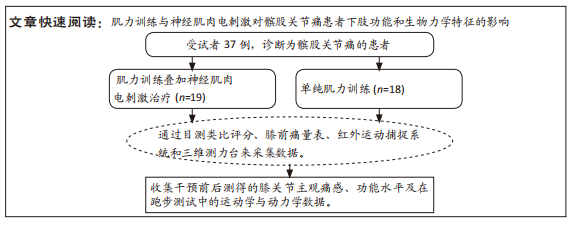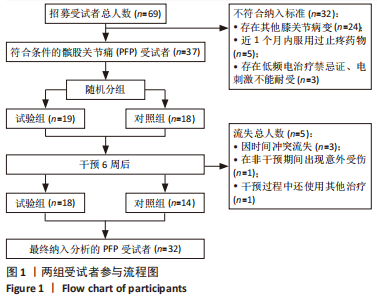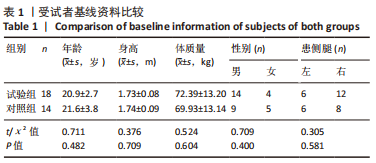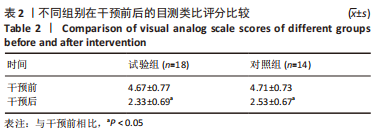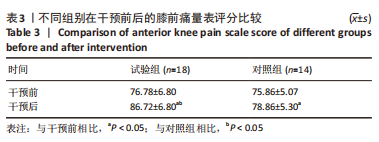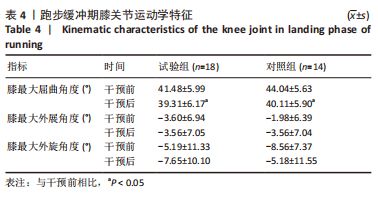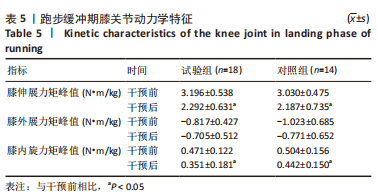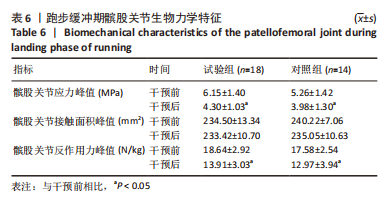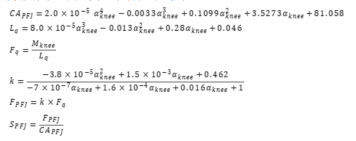[1] ASHNAGAR Z, HADIAN MR, SAJJADI E, et al. Quadriceps architecture in individuals with patellofemoral pain: A systematic review. J Bodyw Mov Ther. 2021;25:248-254.
[2] 杨辰,曲峰,刘卉,等.髌股关节痛业余跑者性别特异的下肢生物力学特征[J].医用生物力学,2020,35(6):672-678.
[3] 陈一言,陆阿明.髌股疼痛综合征下肢动作模式特征与康复治疗研究进展[J].医用生物力学,2022,37(3):555-561.
[4] CROSSLEY KM, STEFANIK JJ, SELFE J, et al. 2016 Patellofemoral pain consensus statement from the 4th International Patellofemoral Pain Research Retreat, Manchester. Part 1: Terminology, definitions, clinical examination, natural history, patellofemoral osteoarthritis and patient-reported outcome measures. Br J Sports Med. 2016;50(14):839-843.
[5] LANKHORST NE, BIERMA-ZEINSTRA SM, VAN MIDDELKOOP M. Factors associated with patellofemoral pain syndrome: a systematic review. Br J Sports Med. 2013;47(4):193-206.
[6] 杨辰,曲峰.髌股关节痛病因、治疗和分组的生物力学研究进展[J].中国运动医学杂志,2017,36(10):927-932.
[7] SAKAI N, LUO ZP, RAND JA, et al. The influence of weakness in the vastus medialis oblique muscle on the patellofemoral joint: an in vitro biomechanical study. Clin Biomech (Bristol, Avon). 2000;15(5):335-339.
[8] FINNOFF JT, HALL MM, KYLE K, et al. Hip strength and knee pain in high school runners: a prospective study. PM R. 2011;3(9):792-801.
[9] FUKUDA TY, ROSSETTO FM, MAGALHAES E, et al. Short-term effects of hip abductors and lateral rotators strengthening in females with patellofemoral pain syndrome: a randomized controlled clinical trial. J Orthop Sports Phys Ther. 2010;40(11): 736-742.
[10] MARTIMBIANCO ALC, TORLONI MR, ANDRIOLO BN, et al. Neuromuscular electrical stimulation (NMES) for patellofemoral pain syndrome. Cochrane Database Syst Rev. 2017;12(12):CD011289.
[11] SAFRAN EE, MUTLUAY F, UZAY A. Effects of neuromuscular electrical stimulation combined with resistance exercises on muscle strength in adult hematological cancer patients: A randomized controlled study. Leuk Res. 2022;121:106932.
[12] MATSUSE H, SEGAL NA, RABE KG, et al. The Effect of Neuromuscular Electrical Stimulation During Walking on Muscle Strength and Knee Pain in Obese Women With Knee Pain: A Randomized Controlled Trial. Am J Phys Med Rehabil. 2020;99(1):56-64.
[13] GLAVIANO NR, MARSHALL AN, MANGUM LC, et al. Improvements in Lower-Extremity Function Following a Rehabilitation Program With Patterned Electrical Neuromuscular Stimulation in Females With Patellofemoral Pain: A Randomized Controlled Trial. J Sport Rehabil. 2020;29(8):1075-1085.
[14] RULAND JR, III MMH, DIDUCH DR. Patellofemoral Pain: Current Concepts. Ann Sports Med Res. 2017;5(4):1118-1121.
[15] RABELO ND, LIMA B, REIS AC, et al. Neuromuscular training and muscle strengthening in patients with patellofemoral pain syndrome: a protocol of randomized controlled trial. BMC Musculoskelet Disord. 2014;15:157.
[16] GLAVIANO NR, HUNTSMAN S, DEMBECK A, et al. Improvements in kinematics, muscle activity and pain during functional tasks in females with patellofemoral pain following a single patterned electrical stimulation treatment. Clin Biomech (Bristol, Avon). 2016;32:20-27.
[17] VAN DER HEIJDEN RA, LANKHORST NE, VAN LINSCHOTEN R, et al. Exercise for treating patellofemoral pain syndrome. Cochrane Database Syst Rev. 2015;1:CD010387.
[18] GLAVIANO NR, MARSHALL AN, MANGUM LC, et al. Impairment-Based Rehabilitation With Patterned Electrical Neuromuscular Stimulation and Lower Extremity Function in Individuals With Patellofemoral Pain: A Preliminary Study. J Athl Train. 2019;54(3):255-269.
[19] KOLLE T, ALT W, WAGNER D. Effects of a 12-week home exercise therapy program on pain and neuromuscular activity in patients with patellofemoral pain syndrome. Arch Orthop Trauma Surg. 2020; 140(12):1985-1992.
[20] NUSSBAUM EL, HOUGHTON P, ANTHONY J, et al. Neuromuscular Electrical Stimulation for Treatment of Muscle Impairment: Critical Review and Recommendations for Clinical Practice. Physiother Can. 2017;69(5):1-76.
[21] 万丽,赵晴,陈军,等.疼痛评估量表应用的中国专家共识(2020版)[J].中华疼痛学杂志,2020,16(3):177-187.
[22] HOTT A, LIAVAAG S, JUEL NG, et al. The reliability, validity, interpretability, and responsiveness of the Norwegian version of the Anterior Knee Pain Scale in patellofemoral pain. Disabil Rehabil. 2021;43(11):1605-1614.
[23] WU G, SIEGLER S, ALLARD P, et al. ISB recommendation on definitions of joint coordinate system of various joints for the reporting of human joint motion--part I: ankle, hip, and spine. International Society of Biomechanics. J Biomech. 2002;35(4):543-548.
[24] DRAPER CE, BESIER TF, SANTOS JM, et al. Using real-time MRI to quantify altered joint kinematics in subjects with patellofemoral pain and to evaluate the effects of a patellar brace or sleeve on joint motion. J Orthop Res. 2009;27(5):571-577.
[25] 权朝鲁.效果量的意义及测定方法[J].心理学探新,2003(2):39-44.
[26] 祁钰杰,王琳.跑步再训练对髌股疼痛综合征跑者髌股关节压力的影响[J].浙江体育科学,2021,43(2):105-112.
[27] LABANCA L, ROCCHI JE, CARTA N, et al. NMES superimposed on movement is equally effective as heavy slow resistance training in patellar tendinopathy. J Musculoskelet Neuronal Interact. 2022;22(4): 474-485.
[28] CROSSLEY KM, BENNELL KL, COWAN SM, et al. Analysis of outcome measures for persons with patellofemoral pain: which are reliable and valid? Arch Phys Med Rehabil. 2004 ;85(5):815-822.
[29] BILY W, TRIMMEL L, MODLIN M, et al. Training program and additional electric muscle stimulation for patellofemoral pain syndrome: a pilot study. Arch Phys Med Rehabil. 2008;89(7):1230-1236.
[30] HU H, ZHENG Y, LIU X, et al. Effects of neuromuscular training on pain intensity and self-reported functionality for patellofemoral pain syndrome in runners: study protocol for a randomized controlled clinical trial. Trials. 2019;20(1):409.
[31] CLAYTON EB, FORSTER A, PALASTANGA N. Clayton’s Electrotherapy: Theory and Practice. Bailliere Tindall Limited, United Kingdom, 1985.
[32] ROBERTSON VJ, WARD AR. Vastus medialis electrical stimulation to improve lower extremity function following a lateral patellar retinacular release. J Orthop Sports Phys Ther. 2002;32(9):437-443.
[33] JOHNSON M, MARTINSON M. Efficacy of electrical nerve stimulation for chronic musculoskeletal pain: a meta-analysis of randomized controlled trials. Pain. 2007;130(1-2):157-165.
[34] KUJAWA M, GOERLITZ A, RUTHERFORD D, et al. Patellofemoral Joint Stress during Running with Added Load in Females. Int J Sports Med. 2020;41(6):412-418.
[35] LABANCA L, ROCCHI JE, LAUDANI L, et al. Neuromuscular Electrical Stimulation Superimposed on Movement Early after ACL Surgery. Med Sci Sports Exerc. 2018;50(3):407-416.
[36] TOTH MJ, TOURVILLE TW, VOIGT TB, et al. Utility of Neuromuscular Electrical Stimulation to Preserve Quadriceps Muscle Fiber Size and Contractility After Anterior Cruciate Ligament Injuries and Reconstruction: A Randomized, Sham-Controlled, Blinded Trial. Am J Sports Med. 2020;48(10):2429-2437.
[37] BORZUOLA R, LABANCA L, MACALUSO A, et al. Modulation of spinal excitability following neuromuscular electrical stimulation superimposed to voluntary contraction. Eur J Appl Physiol. 2020;120(9): 2105-2113.
[38] COLLINS NJ, BARTON CJ, VAN MIDDELKOOP M, et al. 2018 Consensus statement on exercise therapy and physical interventions (orthoses, taping and manual therapy) to treat patellofemoral pain: recommendations from the 5th International Patellofemoral Pain Research Retreat, Gold Coast, Australia, 2017. Br J Sports Med. 2018; 52(18):1170-1178.
[39] HAGHIGHAT F, EBRAHIMI S, REZAIE M, et al. Trunk, pelvis, and knee kinematics during running in females with and without patellofemoral pain. Gait Posture. 2021;89:80-85.
[40] TAKABAYASHI T, EDAMA M, INAI T, et al. A mathematical modelling study investigating the influence of knee joint flexion angle and extension moment on patellofemoral joint reaction force and stress. Knee. 2019;26(6):1323-1329.
[41] CHIU JK, WONG YM, YUNG PS, et al. The effects of quadriceps strengthening on pain, function, and patellofemoral joint contact area in persons with patellofemoral pain. Am J Phys Med Rehabil. 2012;91(2):98-106.
[42] WANG B, YANG Y, ZhANG X, et al. Twelve-Week Gait Retraining Reduced Patellofemoral Joint Stress during Running in Male Recreational Runners. Biomed Res Int. 2020;2020:9723563.
[43] SHERMAN SL, PLACKIS AC, NUELLE CW. Patellofemoral anatomy and biomechanics. Clin Sports Med. 2014;33(3):389-401.
[44] CELIK D, ARGUT SK, TURKER N, et al. The effectiveness of superimposed neuromuscular electrical stimulation combined with strengthening exercises on patellofemoral pain: A randomized controlled pilot trial. J Back Musculoskelet Rehabil. 2020;33(4):693-699.
[45] AKARCALI I, TUGAY N, KAYA D, et al. The role of high voltage electrical stimulation in the rehabilitation of patellofemoral pain. Pain Clin. 2013;14(3): 207-212.
[46] ALMONROEDER TG, BENSON LC. Sex differences in lower extremity kinematics and patellofemoral kinetics during running. J Sports Sci. 2017;35(16):1575-1581.
[47] SINAEI E, FOROOZANTABAR V, YOOSEFINEJAD AK, et al. Electromyographic comparison of vastus medialis obliquus facilitatory versus vastus lateralis inhibitory kinesio taping in athletes with patellofemoral pain: A randomized clinical trial. J Bodyw Mov Ther. 2021;28:157-163. |
